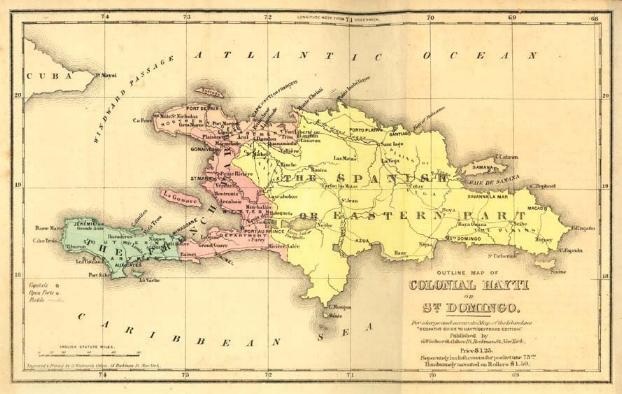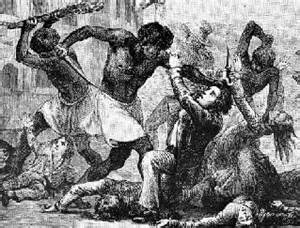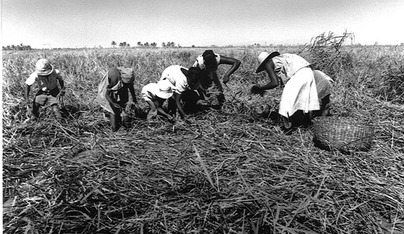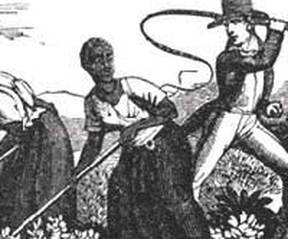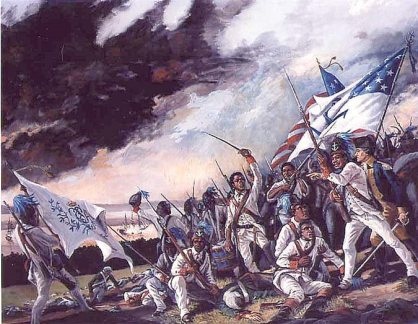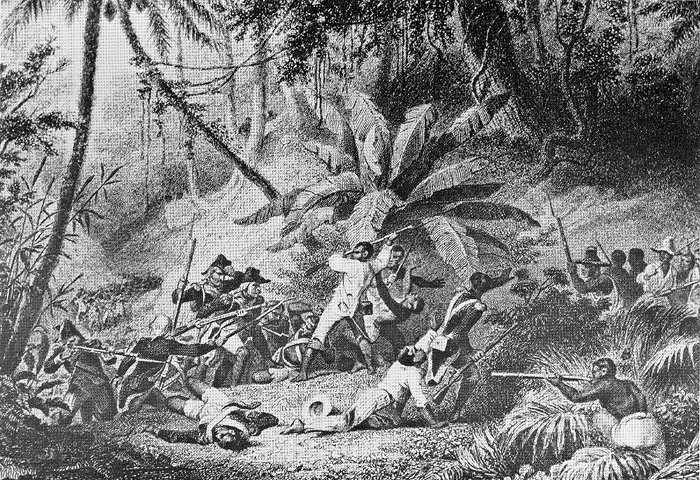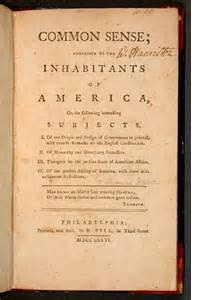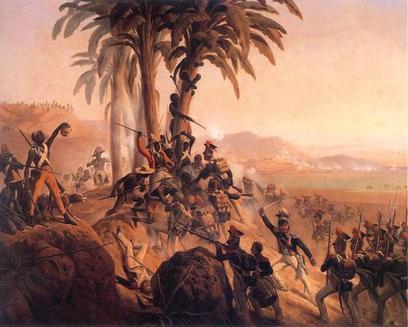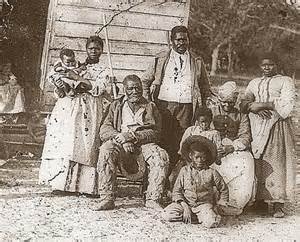AGMSPRITE
Abigail Hager, Jason McEntire, Schuler
ArtThe art from this time period in Haiti depicts children, whites, and people just being slaughtered in the streets with violent weapons with a very clear race line showing. It can be deduced that the slaves did not care who they killed as long as those people were white. The Spanish and British egged this on, meanwhile. This really did not do anything but make it more bloody. In one of the images a former slave is seen holding up the head of who can be assumed to be a general. This shows that the Haitians were trying to make a point more than anything, but it also shows that they had a focus on killing off the leaders, as can be seen in another picture showing them hanging a white male who was in military clothes. Eventually, in 1804, the rebellion came to a close with Haitians being freed and there was a black leader, but due to their inability to lead themselves as well as the lack of money that happened post-killing all of the rich people, their success was not long-lasting.
|
GeographyCauses
Haiti was a French Caribbean Colony, which meant it had tropical weather, which was very good for the world’s largest cash crops. Haiti had some 8,000 plantations that produced about 40% of the world’s sugar and about 50% of its coffee. As a nation is also produced cocoa, indigo, tobacco, cotton, sisal as well as some fruits and vegetables for the motherland, France. The colony was run on slave labor and made up most of the population (500,000 slaves, 32,000 whites, and 28,000 free blacks). This lead to a very strict class System. This social ladder was determined predominantly on whether you were a slave or not, and also on the basis of skin color and race, seeing as how some blacks living on the colony were freemen. The more African blood you had in your family lineage, the lower on the social ladder you were. The people were sharply divided between the extremely wealthy plantation owners, merchants, and lawyers and what was known as the petits blancs (“poor whites”). Almost all blacks in Haiti were slaves while the white Frenchmen lived in high class luxury, which created sharp distinctions between the lowest and highest classes. Because of that social class based on race, fueled by the slavery that the colony was used for, the Haitian Revolution formed. Effects The in-fighting led to 3 general provinces: The North outlined by the area where the Ogé and slave revolts first took place; The West, which was the area under British occupation from 1793-98, in the middle of the revolution; and the South, which was where most of the free colored people lived between 1791 and 1799. These were all the results of the first successful large-scale slave rebellion in history. Being a slave rebellion, the slaves gained freedom from their masters and plantation owners. Despite Haiti being the second independent state of the Americas, and the mentioned positive effects that the Haitian Revolution had on the island and its people, the United States initially refused to recognize the new nation. However, this soon changed as both America and France required Haiti for economic interests. |
|
MilitaryBefore the revolution there was not so much of a class struggle there, as there was a race struggle. Almost all blacks in Haiti were slaves while the white Frenchmen lived in luxury. In the shadow of the French revolution a slave revolt broke out, but it wasn’t so extreme at first; it was a voodoo ceremony that kicked it all off. This led to their rights being further repressed and eventually them standing up for themselves.There was fighting between the poor whites and rich whites, whites and blacks, and French forces fighting Spanish and English forces. The fighting destroys most of the island's infastructure and plantations.
|
SocialCauses
The revolution was caused mainly by the division between social classes in Haiti. The petits blancs, or "poor whites," were the lowest white class in the colony. They wanted more economic equality between them and the majority of the white population, who were extremely wealthy. These rich whites, or "grand blancs" were a combination of plantation owners, merchants, and lawyers. Once the petits blancs heard about the revolution taking place in France they were inspired to start one of their own. The 500,000 slaves on the island, who actually outnumbered the French settlers by over a factor of 10 (there were only 40,000 French) were also looking for a change. The slaves were overworked and had inadequate clothing, food, shelter, and medical care, and the punishments they had were also very violent and extreme. These included whipping, burning, and even castration. Effects The free men of color were at first granted citizenship, along with some civil and political rights in 1792. However, the National Convention in France by abolishing slavery within its own borders a |
Politics |
ReligionCauses
Voodoo versus Christianity was the only religious issue during the revolution. The two religious ideals weren't what was conflicted, it was the people that practiced them, and the social divisions that they represented. In Haiti only the uneducated blacks (slaves, runaway slaves, and most free blacks) practiced their regional religion, commonly referred to as “voodoo” by the whites. Only the whites practiced Christianity, the high class and the low class The mass conflict between black and whites was the problem, and the two differing religions of Haiti reflected this. Effects The Haitian revolution led to less Christianity as a whole. After the revolution, and the mass killing or expelling of whites from the island, the entire population was mostly blacks, more than 20 blacks to 1 white person. That meant that the regional religion, or “voodoo”, was the prominent religious force, and Christianity had little appeal to the population. |
IntellectA Revolution of the Enlightenment
The Enlightenment ideas that prevailed in the Haitian Revolution were those of Locke, Voltaire, Smith, and Rousseau. Locke’s ideas of Natural Rights and the government protecting them was the number one ideal in this revolution, and thus the new government formed. Adam Smith was also very prevalent, his ideas of free markets and the “invisible hand” was very popular, since the French Government banned Haiti from trading with anyone but France. After the revolution however, they were cut off from much of the trade, so Smith’s ideas were used to form the government, but were not able to be used. Voltaire and Rousseau were equally as powerful, with their similar ideas of Freedom of Expression, Liberty, and Popular Sovereignty in government. Less prevalent was Hume with his ideas of the intertwining Liberty and Necessity, but it was a part of the general ideals. The Enlightenment ideas that didn’t prevail in the Haitian Revolution were those of Hobbes, Montesquieu, Diderot, and Paine. Hobbes’ ideas of an Absolute Monarchy was what Haiti was trying to avoid, and Paine’s Common Sense was also irrelevant in this revolution, but was during the American Revolution. Haiti had little government organization of their own, they formed the same as the French rule that had preceded them, so Montesquieu’s ideas of the 3 branches of government was not an issue. Also irrelevant was Diderot’s Encyclopedie; while it had good ideas and information, it was not used for anything in the new government. |
Economy
Causes
Before the revolution, the French Caribbean colony of Saint Domingue (soon to become Haiti) was essentially the richest colony in the world. Some 8,000 plantations produced about 40 of the world’s sugar and about half of its coffee. The colony was run on slave labor and made up most of the population (500,000 slaves, 400,000 whites). The people were sharply divided between the extremely wealthy plantation owners, merchants, and lawyers and what was known as the petits blancs (“poor whites”). Another social group was those of mixed race background. Given its enormous inequalities among the wealthy and poor and the vast amount of slave labor, a revolution was easily set off when news of the French Revolution reached them. Effects With the extreme violence of the revolution, many wealthy white plantation owner and merchants were killed in the fighting and chaos. This, along with the freeing of the slaves lead to economic upheval on the island. most of the plantations fell into disrepair or were razed in the fighting. With the majority of the population becoming subsistant farmers and trade ending, Hati goes into ecomonic ingominity and is now the poorest country in the western heimisphere. |
